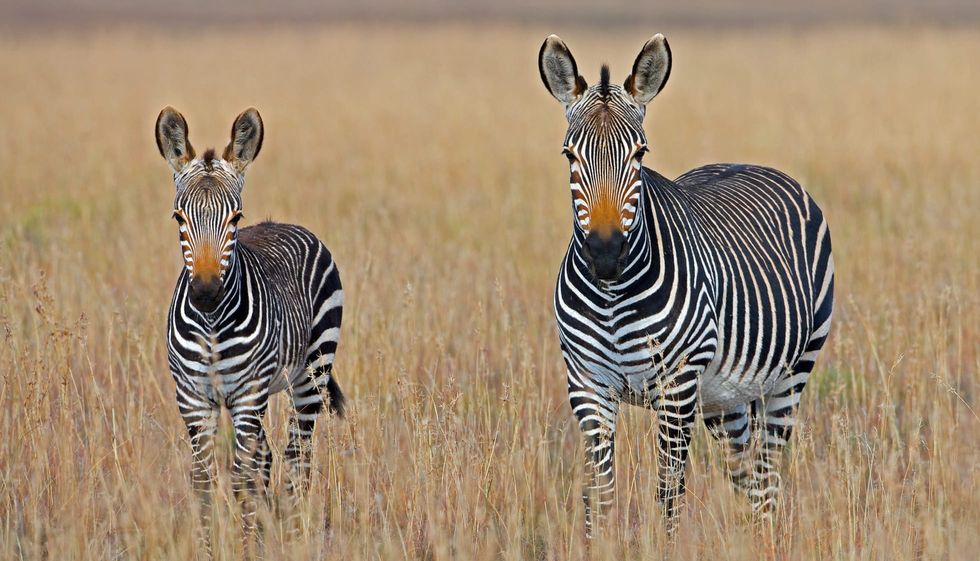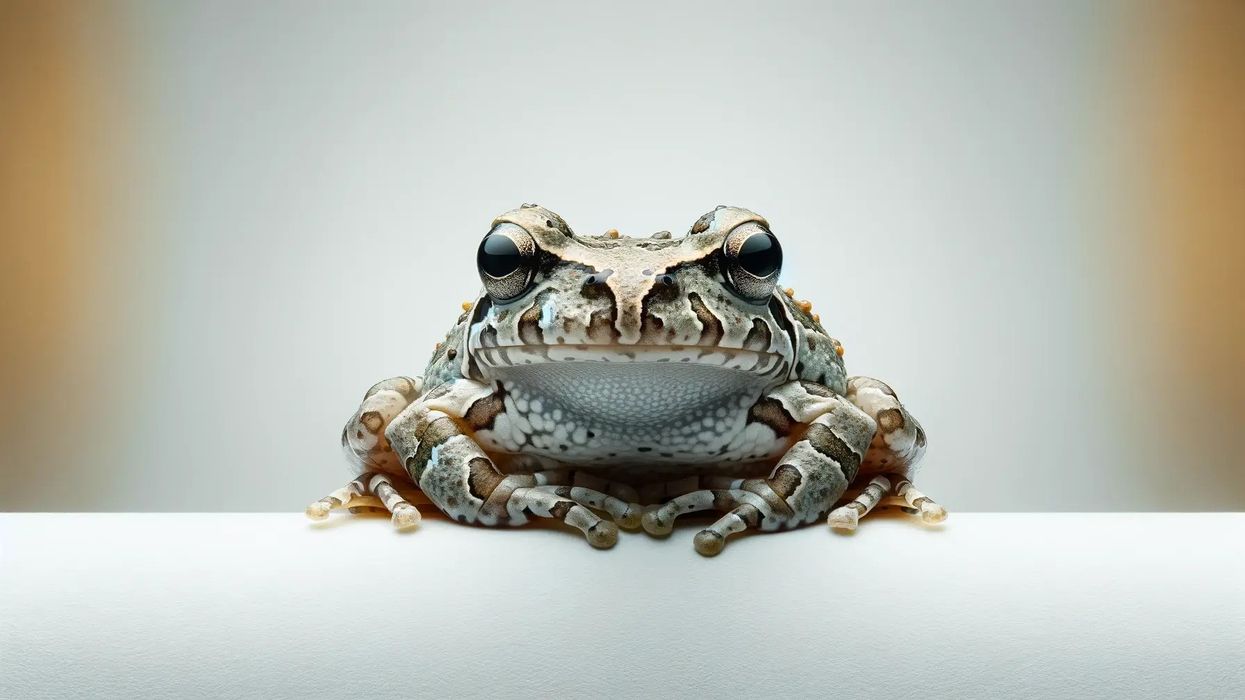Mountain zebras (Equus zebra) is a species of zebras. They can further be classified into two subspecies, the Cape Mountain zebra (Equus zebra zebra) and Hartmann's mountain zebra (Equus zebra hartmannae).
They are found in South Africa, Namibia, and Angola on dry mountain ranges, hills, slopes, and plateaus. Mountain zebras have a black and white striped pattern all over their body, but not the stomach.
Their stomachs are colored either white or off-white. Due to their pointed hooves, mountain zebras find ease in climbing high mountain ranges higher than 2,000 feet above sea level.
Mountain zebras are day animals and are active in the early morning, late afternoon, till sunset. Their diet includes grass, twigs, barks, bushes, grains, and water as herbivores. They are common prey for large carnivore cats.
The mountain zebra is one of the animals that majorly contributes to maintaining an ideal ecosystem. The mountain zebra's population is endangered by human activities like hunting, construction of colonies, and climate change, has decreased in great numbers over the years. It is now a species vulnerable to extinction.
If you liked our compilation of interesting Hartmann's mountain zebra and Cape mountain zebra facts, you might also enjoy going through elephant shrew and plains zebra.
Mountain Zebra Interesting Facts
What type of animal is a mountain zebra?
A mountain zebra is one of the three species of Zebras.
What class of animal does a mountain zebra belong to?
The mountain zebra belongs to the Mammalia class of the Animalia family.
How many mountain zebras are there in the world?
As per the IUCN red list (International Union for Conservation of Nature), the mountain zebra population is 9,000 globally.
Where does a mountain zebra live?
They are found in mountainous and hilly parts of Eastern and Southern Africa, particularly in South Africa, Namibia, and Angola, with arid and temperate climates.
What is a mountain zebra's habitat?
Mountain zebras' natural habitat is mountains, dry-rocky-hilly regions, slopes, and plateaus. They are also found in deserts and semi-deserted regions.
Who do mountain zebras live with?
Mountain zebras live with their families. Unlike other zebras that move in large herds on 30, mountain zebras move in small herds with one adult stallion and five mares with their offspring. Stag stallions live alone, in search of a mare to mate.
How long does a mountain zebra live?
A mountain zebra lives up to 20 years. One of Hartmann's mountain zebras lived for 26 years, which is an unbroken record for the species.
How do they reproduce?
Breeding herds of mountain zebras remain together for life since they are polygynous. They form small herds of one stallion and five mares. Mountain zebra mares reach maturity aged between three to six years. After mating, the mares undergo a gestation period of 10 months, post which a foal is produced.
Mountain zebra foals can stand and walk within a few hours after birth and are weaned after 10 months of birth.
Mares can reproduce one foal every two to three years up to 24. The young male foal is forced out of the herd once a new foal is born.
What is their conservation status?
The current status of conservation of mountain zebra is Vulnerable.
Mountain Zebras Fun Facts
What do mountain zebras look like?

Mountain zebra is covered with deep brown or black and white stripes closely placed all over the body, along the long tail with a tuft at the end. It has a short mane running by the neck's length till the belly, which is unstriped and colored white.
A noticeable characteristic of the mountain zebra is the dewlap, a fold of skin hanging from its neck.
It has ears standing erect over the head, which can be as long as eight inches. It has round eyes with binocular vision and can see in color.
Fun fact, the stripes pattern helps zebras reflect most of the sun's heat, thereby making them adapt to the hot climates of South Africa.
The mountain zebra belongs to the Mammalia class, order Perissodactyla, meaning they are odd-toed and bear all of their body weight on one toe, helping digest cellulose from plants. With four hard and pointed one-toed hooves, the mountain zebra can reach any rocky mountain range with ease.
How cute are they?
Mountain zebras, especially foals, are beautiful and cute animals with a black and white striped pattern.
How do they communicate?
Mountain zebras communicate through body language, noises, and with the eyes. They bray and make sounds near each other's ears to get their point clear. It may seem funny, but they widen their eyes and show their broad teeth to communicate with their peers.
In case of danger, they snort and make a loud noise to alert the herd.
How big is a mountain zebra?
The mountain zebra is one of the three species of zebras, the other two being Grevy's zebra and plains zebra. The Equus zebra, (mountain zebra) is smaller than the former and more prominent than the latter. They can grow as tall as 87.7 in with a body length of 48-54 in.
In the two subspecies of mountain zebras, the Cape mountain zebra is smaller than Hartmann's Mountain zebra in height and length.
How fast can a mountain zebra run?
A mountain zebra can run at a speed of 40 miles an hour. They are slower than horses, but their speed evolved to escape their predators.
How much does a mountain zebra weigh?
Mountain zebras averagely weigh between 485-893 lb. A stallion can weigh between 551-661 lb and a mare between 515-608 lb. Both genders of Hartmann's mountain zebra weigh more than Cape mountain zebra.
What are their male and female names of the species?
Like other zebra species, a male mountain zebra is referred to as a stallion, and a female is called a mare.
What would you call a baby mountain zebra?
A baby mountain zebra is called a foal; some individuals also called them zebra cubs. A male foal is referred to as colt and a female foal as finny.
What do they eat?
Mountain zebras are herbivores that survive on greens and water. They mainly chew on grass, twigs, leaves, barks, shrubs. Mountain zebras also eat nuts, seeds, and grains. With an excellent sense of taste, they can easily detect food quality changes.
Mountain zebras are crepuscular animals. They spend the day grazing and drinking water in the daylight hours, in the morning and late afternoon, and rest in the night.
They drink water twice every day and have great senses, enabling them to find water anywhere. When mountain zebras do not find surface water, they can travel up to 20kms (12.5 miles) to find groundwater near dry river beds.
Are they preyed upon?
A Mountain zebra's predators are carnivores like lions, cheetahs, hyenas, hunting dogs, and leopards.
Would they make a good pet?
Having a mountain zebra as a pet is debatable. Although it is legal in most parts of the world to own a zebra, it is best to do so only if you can provide it with a suitable habitat.
Being a wild animal, the mountain zebra can be an open invitation for carnivores to enter your home, but a zebras kick could kill them if it gets the right place.
Did you know...
Here are some interesting facts about zebras of the mountain.
It is interesting to know about the mountain zebra food chain. Their diet makes mountain zebras great disperses of seeds across their natural range map of breeding as herbivores.
This levels up the mesopredator population, which are medium-sized predations like foxes, snakes, cougars. It helps maintain a balance in the ecosystem where larger predators can also prey on these animals.
Although there isn't much proof of playful activity amongst the Cape mountain zebra, Hartmann's mountain zebras are often found play-fighting, racing, and chasing each other amongst their small herd.
Interestingly, no two mountain zebra individuals can exactly look alike, even within the subspecies. Each of them has a different pattern of stripes.
Mountain zebra vs plains zebra
Plains zebra or Burchell's zebra (Equus quagga burchelli) is the most common zebra species found in treeless grasslands and savannah woodlands of East and South Africa but is not seen in deserts or rocky regions like the mountain zebra.
Although they breed in small herds, plains zebras join with other units of up to 80 herds, which is not the case for the mountain zebra, which remain in small family groups.
A plain zebra can be larger than mountain zebra but has shorter ears in terms of appearance. The former has stripes joining around the stomach, which fade around the legs, while the latter has no stripes on the stomach, but bold stripes on the rest of the body, including the legs.
Are mountain zebras endangered?
As stated in the IUCN red list in 2008, the two subspecies of mountain zebra (Cape mountain zebra and Hartmann's mountain zebra) went from Endangered to Vulnerable. The species' endangerment's primary reasons were habitat loss, hunting, and competition for resources like grass and water.
The species was under threat when hunting, and resources' competition became significant threats to zebras. In the 1930s, Cape mountain zebras' population fell to 100 for being prey to hunters.
In the 1950s, about 50,000 to 75,000 individuals of the Hartmann's mountain zebra species throttled to 8,000 individuals by 1992 since ranchers disliked wild animals wasting natural resources like grass and water. It led to the massive execution of herds of zebras.
Later, the mountain zebra National Park was established, providing an excellent habitat range for the species, which majorly contributed to the increase in Cape mountain zebras' population from 100 to 1500. Close to 8,000 Hartmann's mountain zebras currently enjoy grazing in Namibia's mountains. International laws and treaties protect both species.
Apart from hunting and resources, loss of habitat is also why the species are still listed as Vulnerable. It is due to an increase in the human population using up natural habitats of mountain zebras to construct humanitarian colonies and tourist spots. Climate change has led to the loss of water and grass, which these herbivores survive.
Today, there are 9,000 adult mountain zebras left in the world. We can hope and contribute to their conservation by not ruining their habitats.
Here at Kidadl, we have carefully created lots of interesting family-friendly animal facts for everyone to discover! Learn more about some other mammals including sumatran elephant, or African civet.
You can even occupy yourself at home by drawing one on our zebra coloring pages.









